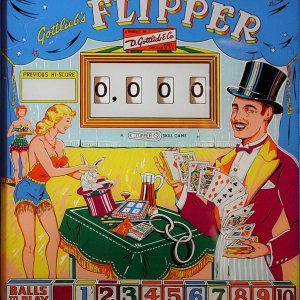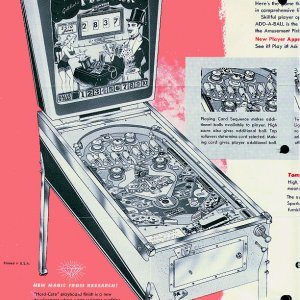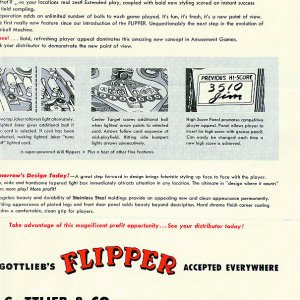'
Flipper' was the first
add-a-ball machine and introduced the concept of extended play. Until this game was made, David Gottlieb was of the firm opinion that "Nothing will replace the
Free play as a game attraction". In fact, prior to this game he had halted an extended play concept for which he was unsatisfied, under development as
Gottlieb's 1960 'Dancing Dolls (Prototype)'.
Alvin Gottlieb tells us that his father's attitude changed upon playing 'Flipper':
After he played Wayne’s first finished production model, he decided to try to get it approved in some foreign markets where a "Free Play" was considered a "Thing of Value" that made it a part of gambling. Suren Fesjian’s Mondial Company managed to get it approved in France and Italy, and the rest is history.
Gottlieb's changeover from
cabinets having wood side rails and square
backboxes to
cabinets having metal side rails and
wedge head backboxes occurred during production of this game. Reportedly, the first 415 units were manufactured as
woodrails and the remaining 685 units as
wedge heads. These numbers have not been confirmed to us. Included in this listing are two examples of this
woodrail cabinet. One is marked 'Sample Game' because of its serial number while the other is marked 'Early Production' because we do not know its serial number. The Sample game has
cabinet art that was not used on the production games, nor have we seen it in any other production run in a search of years 1950-1965. A close comparison showed up in the lower
cabinet art of
Gottlieb's 1963 'Square Head'.
The
woodrail version was the last game to have Gottlieb's famous phrase on the backglass:
Amusement Pinballs, as American as Baseball and Hot Dogs! The first game to have it was
Gottlieb's 1955 'Marathon'. The phrase did not appear on the wedgehead version nor on later games.
Wayne Neyens tells us why Gottlieb began using the
wedge head design:
When the flipper games came on location we soon heard complaints about side by side games. It was hard to keep the games in line and separated so that there was room for two pairs of hands. Well the four player solved the problem, the lite box did the job of separation. The answer became obvious, we needed to increase the size of the lite box on single player games. I believe that Doc [Roman F. "Doc" Garbark, head of mechanical engineering at Gottlieb] came up with the WEDGE HEAD design. It was cheaper for us to spend a little more money on the cabinet than to buy a larger glass, more art work, and screens, etc. Also, it was a new look, a win win deal for us. I don't know who hung the name WEDGE HEAD on the design but it is very descriptive.
This
wedge headbackbox came out thirteen years after the debut of the
EMflipper, and we do not know why the complaints were seemingly endured by Gottlieb (and, presumably, by the pinball industry) for that length of time before a solution was at hand. We have not found a pinball game prior to 1960 that has a
wedge headbackbox, although we believe many European pinball games for this time frame have yet to be documented.





